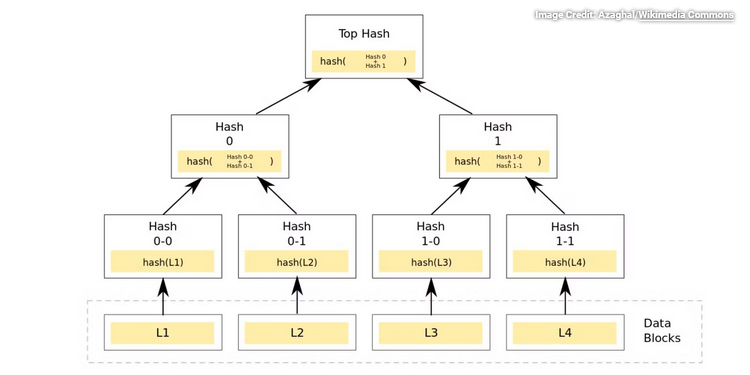What Is a Merkle Tree and How Does It Work in Crypto?

Blockchain and cryptocurrencies occupy a wide and complicated landscape. This machine contains numerous cogs, including a Merkle tree. Merkle trees are important in blockchain functionality, but what do they do? What is a Merkle tree, and why is it important in blockchain technology?
How Does a Blockchain Work?
Before delving into the Merkle tree’s dynamics, it’s important to understand how blockchains work.
In its most essential form, a blockchain is a virtual chain of blocks, each having its own data set. Each block secures data and keeps it out of the hands of bad actors by utilizing cryptography, notably hashing.
Blockchains are most often employed in cryptocurrency, where each transaction involving a specific asset is recorded on its original blockchain. Furthermore, each transaction is chronologically recorded and visible to the entire blockchain (via tools such as a blockchain explorer).
A blockchain transaction cannot be changed or removed. Instead, data is encoded using mathematical techniques via a process known as hashing. These techniques can convert any character length into a fixed, encoded length.
Merkle trees are essential for documenting transactions on a blockchain. But how does a Merkle tree function?
What Is a Merkle Tree?
The term “Merkle tree” has two meanings. First, “Merkle” refers to Ralph Merkle, an American computer scientist and mathematician who significantly contributed to public-key cryptography. Merkle first introduced binary hash trees in his 1987 paper “A Digital Signature Based on a Conventional Encryption Function.” Merkle is also credited with inventing cryptographic hashing, utilized in the Merkle tree.
The “Merkle tree” structure is responsible for the second part of its name. A Merkle tree (also known as a binary hash tree) is a data structure that resembles a tree. Merkle trees have “branches” and “leaves,” with each “leaf” or “branch” having a data block hash.
A Merkle tree, in summary, simplifies the process of storing transactional hashes on a blockchain. It aggregates all transactions within a single block and efficiently encodes them as a hash for safer and faster storage. Furthermore, the validity of the data can be swiftly checked using a Merkle tree via one final hash. This not only streamlines the data storing process, but it also ensures security integrity.
Merkle trees also do not necessitate a lot of processing resources. They cut down on the storage space needed for data by combining many transactions hashes into one. The utilization of resources has long been a cause of dispute in the cryptocurrency business, as blockchain networks can consume a significant amount of storage space and electricity. As a result, adopting Merkle trees helps to mitigate this issue. Furthermore, on-chain data storage can also be expensive. Therefore employing Merkle trees to cut data can help blockchain platforms save money.
The Merkle tree process is also relatively short, which is good news for efficiency. After all, many blockchains (including Bitcoin) have been criticized for their long transaction times. Thus any process that might help with this issue is a benefit.
Merkle trees are employed in various computing fields, most notably cryptography and encryption, but they are most recognized for their role in Bitcoin blockchains. In addition, the Merkle tree is used by Bitcoin, Ethereum, Dogecoin, and all other cryptocurrencies. Hence it is unquestionably important.
So, how exactly does it work?
How Does a Merkle Tree Work?
A Merkle tree is seen in the diagram below. There would be many more transactions and hashes per tree in reality. However, this illustration simplifies the process so you can understand the stages required.
Things appear to be complicated in this Merkle tree diagram. However, the Merkle tree hashing process is extremely simple when broken down.
There are several steps involved in the Merkle tree process. The hashes at the base of the Merkle tree are called leaves, while the hashes in the middle are called branches. The branches are also known as non-leaf nodes at times. The data blocks (or transactions) from which the hash will arise are shown at the bottom of the diagram.
Each node’s initial transactions are hashed in pairs, with one hash remaining. Then, pair after pair is hashed into one until a single hash emerges, and the process stops. If a block contains an odd number of transactions, one will be replicated to match it with the original for hashing.
Though the final hash appears at the top of the above diagram, it is referred to as the tree’s “root” (the root hash). The root is the sum of all the individual hashes of transactions in the block. Each block must have one Merkle tree, meaning each must have one Merkle Root data field.
You’ve probably heard of the Merkle Root or Merkle Hash if you’ve researched blockchains. A hashMerkleRoot is anything that resides within a block. This data (the ultimate hash at the end of the tree) is stored in each block’s block header. A blockchain block also contains additional data, such as a date, asset version number, and the “nonce” (number used only once).
Can Blockchains Function Without Merkle Trees?
While Merkle trees aren’t essential for a blockchain, they play an important role in data security.
Cryptocurrency blockchains demand additional resources and time to carry out crucial functions without Merkle trees. To begin, each node in the network would be required to store its copy of every transaction performed on the blockchain. On larger blockchains, hundreds of thousands of transactions can occur in a single day, so adding such a volume of data to each node’s copy would undoubtedly consume a lot of space.
Furthermore, Merkle trees are important in data verification. Validators and miners can verify whether the block is valid to be added to the blockchain using the single root hash at the end of the tree. It saves time and storage space to authenticate data without wading through every transaction.
Merkle Trees Are Key in Blockchain Functionality
Merkle trees provide blockchains with security and efficiency without taking up much space. This ingenious encryption process enables blockchains to run without consuming unnecessary resources. Merkle trees aren’t required, although they are extremely useful regarding time, storage space, and data authentication.






